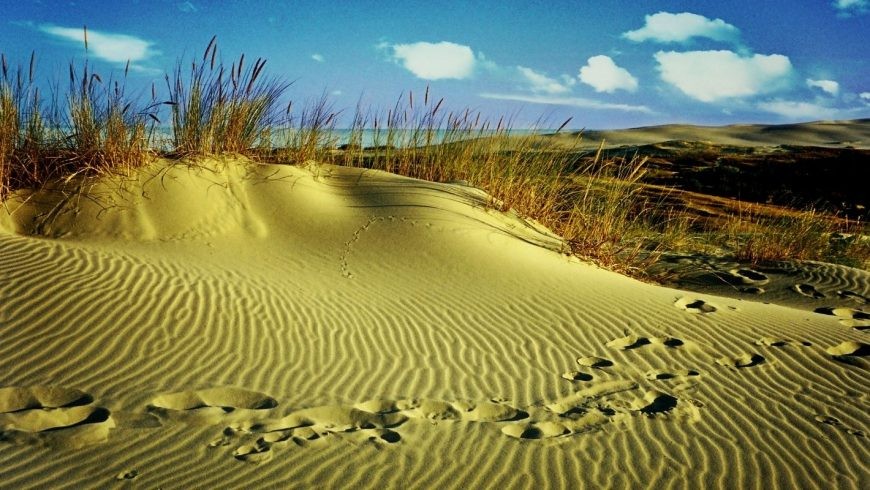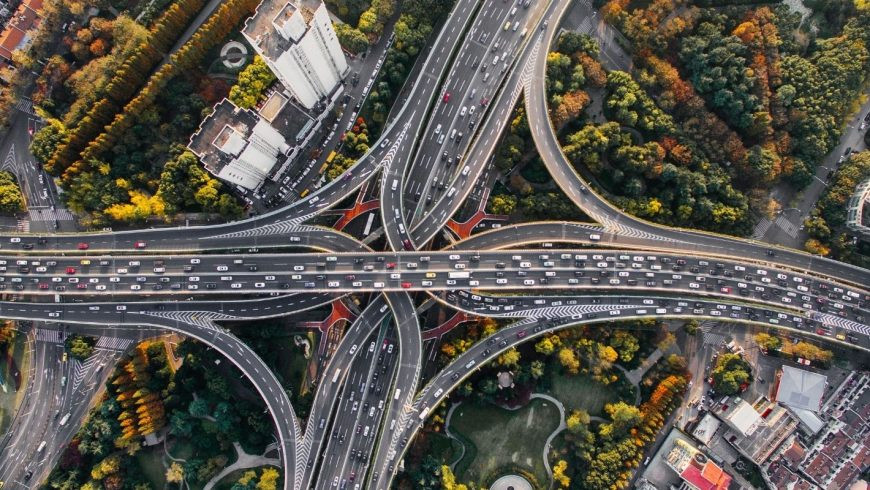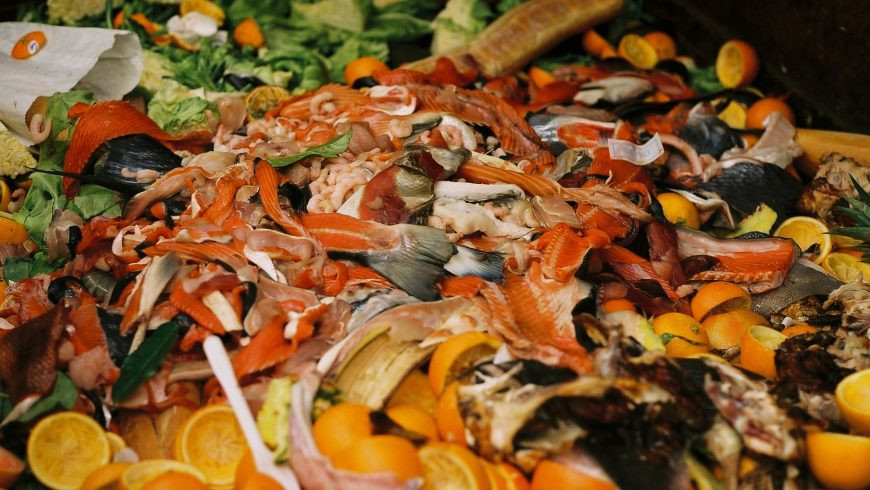Tourism, while offering enriching experiences and economic benefits, significantly contributes to climate change. Let SIXT.VN guide you through understanding this impact and discovering solutions for sustainable travel in Vietnam. Embrace eco-friendly travel options for a greener future.
1. Understanding Tourism’s Carbon Footprint
Tourism is responsible for approximately 8% of global CO2 emissions, a figure that continues to rise. According to a 2018 study in Nature Climate Change, tourism-related emissions are projected to increase by 4% annually. This highlights the urgent need to address and mitigate the environmental impact of tourism.
 Aerial view of a crowded beach with clear turquoise water and white sand, showcasing the popularity of coastal tourism
Aerial view of a crowded beach with clear turquoise water and white sand, showcasing the popularity of coastal tourism
1.1. What are the Main Sources of CO2 Emissions in Tourism?
The main sources of CO2 emissions in tourism include transportation, accommodation, and food services. Each of these sectors contributes significantly to the overall carbon footprint of tourism activities.
1.2. How Does Transportation Contribute to Tourism’s Carbon Footprint?
Transportation accounts for nearly half (49%) of all CO2 emissions from tourism. Air travel is the most significant contributor, followed by automobiles and motorcycles. Buses, trains, and ferries have a relatively lower impact. Consider exploring Vietnam with SIXT.VN’s reliable and potentially eco-friendlier transportation options.
1.3. What is the Impact of Accommodation on Climate Change?
Accommodation facilities, including hotels and resorts, contribute to climate change through both direct and indirect emissions. Direct emissions come from energy consumption for heating, cooling, and lighting, while indirect emissions result from construction processes and the use of building materials.
1.4. How Does Food Consumption and Waste Affect Climate Change in the Tourism Industry?
Food consumption and waste within the tourism industry is a substantial concern, with a significant portion of carbon emissions stemming from food production and disposal. Approximately one-third of food produced globally is wasted, contributing to greenhouse gas emissions. Reducing food waste and sourcing local, seasonal products are crucial steps toward mitigating this impact.
2. The Role of Transportation in Tourism’s Climate Impact
Transportation is a critical factor in understanding how tourism contributes to climate change, accounting for a significant portion of the industry’s overall carbon footprint. Air travel, in particular, is a major concern due to its high emissions per passenger mile.
 A busy international airport with planes taking off and landing, showcasing the carbon emissions associated with air travel
A busy international airport with planes taking off and landing, showcasing the carbon emissions associated with air travel
2.1. Why is Air Travel the Most Polluting Means of Transportation in Tourism?
Air travel is the most polluting means of transportation in tourism because airplanes consume large amounts of fuel and release greenhouse gases directly into the upper atmosphere. This has a disproportionately high impact on global warming. Opt for SIXT.VN’s convenient airport transfer services to start your journey with a reduced carbon footprint.
2.2. What Alternatives Can Tourists Consider to Reduce Transportation Emissions?
To reduce transportation emissions, tourists can consider alternatives such as trains, buses, and ferries, which have lower carbon footprints compared to air travel. Choosing destinations closer to home can also significantly reduce travel-related emissions.
2.3. How Can Sustainable Transportation Options Be Promoted in Vietnam?
Sustainable transportation options in Vietnam can be promoted through investments in public transportation infrastructure, incentives for electric vehicles, and the development of cycling and walking paths. Encouraging tourists to use these options can help reduce the environmental impact of tourism.
2.4. What is SIXT.VN Doing to Promote Sustainable Transportation?
SIXT.VN is committed to promoting sustainable transportation by offering eco-friendly vehicle options, optimizing routes for fuel efficiency, and partnering with local businesses that prioritize sustainability. By choosing SIXT.VN, you contribute to a greener travel experience.
3. The Impact of Tourist Accommodation on Climate Change
Tourist accommodations, such as hotels and resorts, have a significant impact on climate change through their energy consumption, construction practices, and waste generation. Understanding these impacts is crucial for promoting sustainable tourism practices.
 A modern, eco-friendly hotel with solar panels and a green roof, illustrating sustainable accommodation practices
A modern, eco-friendly hotel with solar panels and a green roof, illustrating sustainable accommodation practices
3.1. How Do Construction Processes Contribute to CO2 Emissions?
Construction processes contribute to CO2 emissions through the extraction, manufacturing, and transportation of building materials. The energy-intensive production of cement, steel, and other materials results in significant greenhouse gas emissions.
3.2. What is the Role of Energy Consumption in Hotels and Resorts?
Energy consumption in hotels and resorts plays a major role in their environmental impact. Air conditioning, heating, lighting, and other electrical appliances contribute to high energy demand, leading to increased CO2 emissions, especially when energy sources are not renewable.
3.3. How Can Renewable Energy Sources Reduce the Carbon Footprint of Accommodation?
Renewable energy sources, such as solar and wind power, can significantly reduce the carbon footprint of accommodation facilities. By investing in renewable energy, hotels and resorts can decrease their reliance on fossil fuels and lower their greenhouse gas emissions.
3.4. What Green Building Practices Can Minimize Environmental Impact?
Green building practices, such as using sustainable materials, implementing energy-efficient designs, and incorporating green roofs and walls, can minimize the environmental impact of tourist accommodations. These practices help reduce energy consumption, conserve water, and promote biodiversity.
3.5. How Can Tourists Choose Eco-Friendly Accommodations in Vietnam?
Tourists can choose eco-friendly accommodations in Vietnam by looking for certifications such as Green Lotus or Travelife, which indicate that the facilities meet certain environmental standards. Websites like Booking.com and TripAdvisor also provide information on sustainable accommodations. Let SIXT.VN assist you in finding eco-conscious hotels that align with your values.
4. The Food Industry and Its Impact on Tourism’s Carbon Footprint
The food industry is a major contributor to global carbon emissions, and its impact on tourism’s carbon footprint cannot be overlooked. Food production, transportation, and waste all play significant roles in this equation.
 A buffet table overflowing with food, illustrating the potential for food waste in the tourism industry
A buffet table overflowing with food, illustrating the potential for food waste in the tourism industry
4.1. How Does Food Waste Contribute to Climate Change?
Food waste contributes to climate change by releasing methane, a potent greenhouse gas, as it decomposes in landfills. Additionally, the energy and resources used to produce, transport, and store uneaten food are wasted, further exacerbating the environmental impact.
4.2. What Strategies Can Reduce Food Waste in Hotels and Restaurants?
Strategies to reduce food waste in hotels and restaurants include implementing portion control, improving inventory management, donating surplus food to local charities, and composting food scraps. Raising awareness among staff and guests about the importance of reducing food waste can also be effective.
4.3. Why is Local and Seasonal Food Important for Sustainable Tourism?
Local and seasonal food is important for sustainable tourism because it reduces the need for long-distance transportation, which contributes to carbon emissions. Supporting local farmers and producers also boosts the local economy and promotes sustainable agriculture practices.
4.4. How Can Tourists Support Sustainable Food Practices While Traveling in Vietnam?
Tourists can support sustainable food practices while traveling in Vietnam by choosing restaurants that source local and seasonal ingredients, avoiding buffets with excessive food offerings, and being mindful of portion sizes. Trying local markets and street food can also be a great way to support local businesses and reduce food waste.
4.5. What Initiatives Are in Place to Promote Sustainable Food Production in Vietnam?
Initiatives to promote sustainable food production in Vietnam include encouraging organic farming, supporting small-scale farmers, and promoting sustainable fishing practices. Government policies and consumer awareness campaigns can also play a crucial role in fostering a more sustainable food system.
5. Ecotourism as a Solution
Ecotourism offers a viable solution to mitigate the environmental impact of traditional tourism. It emphasizes responsible travel to natural areas, conserving the environment, and improving the well-being of local people.
 A group of tourists hiking through a lush rainforest, showcasing ecotourism and sustainable travel
A group of tourists hiking through a lush rainforest, showcasing ecotourism and sustainable travel
5.1. What are the Principles of Ecotourism?
The principles of ecotourism include minimizing environmental impact, respecting local culture, providing economic benefits to local communities, and educating travelers about conservation. Ecotourism also aims to promote responsible travel practices and sustainable development.
5.2. How Can Ecotourism Benefit Local Communities in Vietnam?
Ecotourism can benefit local communities in Vietnam by providing employment opportunities, generating income through tourism-related businesses, and supporting the preservation of local culture and traditions. It can also incentivize communities to protect natural resources and biodiversity.
5.3. What Ecotourism Destinations Are Available in Vietnam?
Vietnam offers a variety of ecotourism destinations, including national parks such as Cuc Phuong and Cat Tien, as well as community-based tourism initiatives in the Mekong Delta and the northern highlands. These destinations provide opportunities for tourists to experience Vietnam’s natural beauty while supporting local communities and conservation efforts.
5.4. How Can Tourists Ensure Their Activities Are Environmentally Responsible?
Tourists can ensure their activities are environmentally responsible by choosing tour operators that follow ecotourism principles, respecting local customs and traditions, minimizing waste, and supporting local businesses. Opting for sustainable transportation and accommodation options is also crucial.
5.5. What Role Does Education Play in Promoting Ecotourism?
Education plays a vital role in promoting ecotourism by raising awareness among travelers about the importance of responsible travel practices and the benefits of ecotourism. Educational programs can also help local communities develop sustainable tourism initiatives and manage natural resources effectively.
6. Sustainable Practices for Reducing Your Tourism Impact
Adopting sustainable practices can significantly reduce the environmental impact of your tourism activities. These practices range from choosing eco-friendly transportation and accommodation to minimizing waste and supporting local communities.
6.1. How Can You Choose Eco-Friendly Transportation Options?
You can choose eco-friendly transportation options by opting for public transportation, such as buses and trains, whenever possible. Consider renting electric or hybrid vehicles, or using bicycles for shorter distances. Walking is also a great way to explore destinations while minimizing your carbon footprint.
6.2. What Criteria Should You Consider When Selecting Sustainable Accommodation?
When selecting sustainable accommodation, look for certifications such as Green Lotus or Travelife, which indicate that the facilities meet certain environmental standards. Consider factors such as energy efficiency, water conservation, waste management practices, and the use of sustainable materials.
6.3. How Can You Minimize Waste While Traveling?
You can minimize waste while traveling by bringing your own reusable water bottle, coffee cup, and shopping bags. Avoid single-use plastics, such as straws and plastic cutlery, and choose products with minimal packaging. Support businesses that prioritize waste reduction and recycling.
6.4. Why is it Important to Support Local Businesses and Communities?
Supporting local businesses and communities is important because it helps boost the local economy, preserve cultural traditions, and promote sustainable development. By purchasing locally made products and services, you can contribute to the well-being of local people and reduce the environmental impact of your tourism activities.
6.5. How Can You Offset Your Carbon Emissions From Travel?
You can offset your carbon emissions from travel by investing in carbon offset projects, such as reforestation or renewable energy initiatives. These projects help reduce greenhouse gas emissions and mitigate the impact of your travel activities. Several organizations offer carbon offsetting services, allowing you to calculate your emissions and purchase offsets accordingly.
7. Government and Industry Initiatives for Sustainable Tourism in Vietnam
Government and industry initiatives play a crucial role in promoting sustainable tourism in Vietnam. These initiatives include policies, regulations, and programs aimed at reducing the environmental impact of tourism and supporting sustainable development.
7.1. What Policies and Regulations Are in Place to Promote Sustainable Tourism?
Policies and regulations to promote sustainable tourism in Vietnam include environmental protection laws, regulations on waste management, and incentives for green building practices. The government also supports ecotourism initiatives and promotes sustainable tourism practices through national tourism strategies.
7.2. How Do Certification Programs Encourage Sustainable Practices?
Certification programs, such as Green Lotus, encourage sustainable practices by providing standards and guidelines for businesses to follow. These programs assess the environmental performance of tourism facilities and award certifications to those that meet the criteria. Certification helps businesses improve their sustainability practices and provides consumers with a way to identify eco-friendly options.
7.3. What Role Do Tourism Associations Play in Promoting Sustainability?
Tourism associations play a key role in promoting sustainability by raising awareness among their members, providing training and resources on sustainable practices, and advocating for policies that support sustainable tourism. They also facilitate collaboration among businesses, government agencies, and local communities to promote sustainable development.
7.4. How Are Local Communities Involved in Sustainable Tourism Development?
Local communities are involved in sustainable tourism development through community-based tourism initiatives, which empower local people to manage and benefit from tourism activities in their areas. These initiatives provide employment opportunities, generate income, and support the preservation of local culture and traditions.
7.5. What Incentives Are Available for Businesses to Adopt Sustainable Practices?
Incentives for businesses to adopt sustainable practices include tax breaks, subsidies, and preferential treatment in government procurement processes. The government also provides grants and technical assistance to businesses that invest in green technologies and implement sustainable practices.
8. The Future of Sustainable Tourism: Trends and Innovations
The future of sustainable tourism is marked by emerging trends and innovations aimed at minimizing environmental impact, enhancing the visitor experience, and supporting local communities.
8.1. What Are the Emerging Trends in Sustainable Tourism?
Emerging trends in sustainable tourism include regenerative tourism, which focuses on restoring and enhancing natural and cultural resources; slow travel, which encourages travelers to spend more time in fewer destinations; and conscious travel, which emphasizes responsible and ethical travel practices.
8.2. How Can Technology Contribute to Sustainable Tourism?
Technology can contribute to sustainable tourism by enabling more efficient resource management, reducing energy consumption, and providing travelers with information on sustainable options. Smart hotels, electric vehicles, and mobile apps that promote sustainable tourism practices are examples of how technology can support sustainability.
8.3. What is the Role of Innovation in Developing Sustainable Solutions?
Innovation plays a crucial role in developing sustainable solutions by driving the development of new technologies, practices, and business models that reduce the environmental impact of tourism. Innovations such as sustainable building materials, renewable energy systems, and waste reduction technologies are essential for creating a more sustainable tourism industry.
8.4. How Can Collaboration Drive Sustainable Tourism Development?
Collaboration among businesses, government agencies, local communities, and research institutions is essential for driving sustainable tourism development. By working together, stakeholders can share knowledge, resources, and best practices, and develop innovative solutions to the challenges facing the tourism industry.
8.5. What are the Long-Term Benefits of Investing in Sustainable Tourism?
The long-term benefits of investing in sustainable tourism include preserving natural and cultural resources, supporting local economies, enhancing the visitor experience, and mitigating the impacts of climate change. Sustainable tourism can also contribute to social equity, environmental protection, and economic prosperity, creating a more resilient and sustainable future.
9. Case Studies of Successful Sustainable Tourism Initiatives
Examining case studies of successful sustainable tourism initiatives provides valuable insights and inspiration for developing and implementing sustainable practices.
9.1. What Examples of Eco-Friendly Hotels Exist in Vietnam?
Examples of eco-friendly hotels in Vietnam include those that have implemented energy-efficient designs, use renewable energy sources, conserve water, and practice waste reduction. Some hotels also support local communities through employment opportunities and community development projects.
9.2. How Have Communities Benefited from Sustainable Tourism Projects?
Communities have benefited from sustainable tourism projects through increased income, employment opportunities, and improved infrastructure. Sustainable tourism can also help preserve local culture and traditions, and incentivize communities to protect natural resources and biodiversity.
9.3. What Sustainable Transportation Initiatives Have Been Implemented?
Sustainable transportation initiatives include the development of electric bus systems, the promotion of cycling and walking, and the use of alternative fuels in transportation vehicles. These initiatives help reduce carbon emissions and improve air quality.
9.4. How Have Sustainable Food Practices Improved Local Economies?
Sustainable food practices, such as sourcing local and seasonal ingredients, have improved local economies by supporting local farmers and producers, reducing transportation costs, and promoting sustainable agriculture practices.
9.5. What Lessons Can Be Learned from These Initiatives?
Lessons that can be learned from these initiatives include the importance of collaboration, the need for clear standards and guidelines, and the value of community involvement. Sustainable tourism initiatives are most successful when they are integrated into broader sustainability strategies and when they provide clear benefits to local communities and the environment.
10. Frequently Asked Questions (FAQ) About Tourism and Climate Change
Here are some frequently asked questions about the relationship between tourism and climate change, addressing common concerns and misconceptions.
10.1. Does Tourism Really Contribute Significantly to Climate Change?
Yes, tourism contributes significantly to climate change, accounting for approximately 8% of global CO2 emissions. Transportation, accommodation, and food services are the main sources of these emissions.
10.2. What is the Biggest Culprit in Tourism’s Carbon Footprint?
The biggest culprit in tourism’s carbon footprint is transportation, particularly air travel, which accounts for nearly half of all CO2 emissions from tourism.
10.3. Can Individual Tourists Make a Difference in Reducing Emissions?
Yes, individual tourists can make a significant difference by adopting sustainable practices such as choosing eco-friendly transportation and accommodation, minimizing waste, and supporting local businesses.
10.4. Is Ecotourism a Viable Solution to the Problem?
Yes, ecotourism is a viable solution as it emphasizes responsible travel to natural areas, conserving the environment, and improving the well-being of local people.
10.5. How Can I Find Eco-Friendly Hotels and Tour Operators?
You can find eco-friendly hotels and tour operators by looking for certifications such as Green Lotus or Travelife, and by researching companies that prioritize sustainability. Websites like Booking.com and TripAdvisor also provide information on sustainable options. Let SIXT.VN assist you in finding these options.
10.6. What Are Some Simple Ways to Reduce My Carbon Footprint While Traveling?
Simple ways to reduce your carbon footprint include using public transportation, bringing reusable water bottles and shopping bags, and supporting local businesses.
10.7. Are There Any Destinations in Vietnam That Are Particularly Committed to Sustainable Tourism?
Yes, several destinations in Vietnam, such as national parks and community-based tourism initiatives, are committed to sustainable tourism practices.
10.8. How Can Governments and Tourism Associations Help Promote Sustainable Tourism?
Governments and tourism associations can help by implementing policies and regulations that support sustainable practices, providing training and resources to businesses, and raising awareness among travelers.
10.9. What Are the Long-Term Consequences of Ignoring Climate Change in the Tourism Industry?
Ignoring climate change in the tourism industry can lead to the degradation of natural and cultural resources, the loss of biodiversity, and the disruption of local economies, ultimately undermining the sustainability of the industry itself.
10.10. Where Can I Learn More About Sustainable Tourism in Vietnam?
You can learn more about sustainable tourism in Vietnam by visiting the websites of tourism associations, government agencies, and organizations that promote sustainable development. SIXT.VN is also a great resource for finding sustainable travel options and information.
Ready to explore Vietnam responsibly? SIXT.VN offers a range of services to make your trip sustainable and enjoyable. From airport transfers to hotel bookings and guided tours, we’re here to help you travel with a smaller footprint. Contact us today at Hotline/Whatsapp: +84 986 244 358 or visit our website at SIXT.VN to plan your eco-friendly adventure. Our address is 260 Cau Giay, Hanoi, Vietnam.



